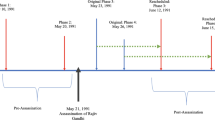Abstract
Political efficacy is considered to be one of the most important attitudes in theories of political participation and democratic politics. It has been assumed that political efficacy is a stable, persistent orientation rather than a transient attitude. Several studies have examined the stability of political efficacy over time. In most of these studies, based on the analysis of the traditional SRC items, the stability assumption has been questioned.
In this paper, we reconsider the stability issue but we adopt a different approach. We distinguish between two components of political efficacy: internal efficacy, a personal attribute and responsiveness, a system attribute, and we study their stability over time. To study the stability of political efficacy and responsiveness over time, we analyse the data with PRELIS and we develop a panel model using LISREL 7. As the observed variables are only ordinal, the estimation of the parameters of the model is based on polychoric correlations and on the weighted least squares method. Our analysis makes use of the Political Action Survey panel data for the USA. This data contains the six SRC efficacy items measured at two occasions. We find that the stability coefficients are higher than those reported in previous research. The difference in the values of the stability coefficients for each component seems to indicate that the personal component is more stable than the system component.
Similar content being viewed by others
References
Abramson P. R. and Aldrich J. H. (1982). “The decline of electoral participation in America”, American Political Science Review 76: 502–521.
Acock A., Clarke H. D., and Stewart M. C. (1985). “A new model for old measures: A covariance structure analysis of political efficacy”, Journal of Politics 47: 1061–1084.
Aish, A. M. and Jöreskog, K. G. (1989). “Political Efficacy: Dimensionality and Measurement”. Submitted for publication.
Asher H. (1974). “The reliability of political efficacy items”, Political Methodology 1: 45–72.
Barnes S. H. and Kaase M. (eds.) (1979). Political Action. Mass Participation in Five Western Democracies. Beverley Hills and London: Sage Publications.
Campbell A., Converse P. E., Miller W. A., and Stokes D. E. (1960). The American Voter. New York: Wiley.
Campbell A. and Converse P. E. (eds.) (1972). The Human Meaning of Social Change. New York: Russel Sage Foundation.
Converse P. E. (1972). “Change in the American electorate”. in A.Campbell and P. E.Converse (eds.): The Human Meaning of Social Change. New York: Russel Sage Foundation, 263–337.
Craig S. C. and Maggiotto M. A. (1981). “Measuring political efficacy”, Political Methodology 8: 85–109.
Cudeck R. (1989). “The analysis of correlation matrices using covariance structure models”, Psychological Bulletin 105: 317–327.
Cudeck R. and Browne M. W. (1983). “Cross-validation of covariance structures”, Multivariate Behavioral Research 18: 147–157.
Easton D. and Dennis J. (1967). “The child's acquisition of regime norms: political efficacy”, American Political Science Review 61: 25–38.
Finkel S. E. (1985). “Reciprocal effects of participation and political efficacy: a panel analysis”, American Journal of Political Science 29: 891–913.
Ginsberg B. (1982). The Consequences of Consent: Elections. Citizen Control and Popular Acquiescence. Reading, Mass: Addison-Wesley.
Ginsberg B. and Weissberg R. (1978). “Elections and the mobilization of popular support”, American Journal of Political Science 22: 31–55.
Greenstein F. I. (1960). “The benevolent leader: children's images of political authority”, American Political Science Review 84: 935–940.
Hess R. D. and Tornay J. V. (1968). The Development of Political Attitudes in Children. Gordon City, New York: Doubleday and Co.
House J. S. and Mason W. M. (1975). “Political alienation in America”, American Sociological Review 40: 123–145.
Jennings M. K. and Niemi R. G. (1978). “The persistence of political orientations: an overtime analysis of two generations”, British Journal of Political Science 8: 333–363.
Jöreskog K. G. (1989). “New developments in LISREL: analysis of ordinal variables using polychoric correlations and weighted least squares”, Quality and Quantity 24: 387–404 (this issue).
Jöreskog K. G. and Sörbom D. (1986). PRELIS-A Program for Multivariate Data Screening and Data Summarization. A Preprocessor for LISREL. Mooresville, Indiana: Scientific Software, Inc.
Jöreskog K. G. and Sörbom D. (1988). LISREL 7-A Guide to the Program and Applications. Chicago: SPSS Publications.
Lane R. E. (1959). Political Life: How and Why People Get Involved in Politics. New York: The Free Press.
Marsh A. and Kaase M. (1979). in S. H.Barnes and M.Kaase (eds.): Political Action. Mass Participation in Five Western Democracies. Beverley Hills and London: Sage Publications.
McPherson J. M., Welch S., and Clarke C. (1977). “The stability and reliability of political efficacy: using path analysis to test alternative models. American Political Science Review 71: 509–521.
Mokken R. (1971). A Theory and Procedure of Scale Analysis. The Hague: Mouton
Olson M. E. (1982). Participatory Pluralism. Chicago: Nelson-Hall.
Olsson U. (1979). “Maximum likelihood estimation of the polychoric correlation coefficient”, Psychometrika 44: 443–460.
Patman C. (1970). Participation and Democratic Theory. Cambridge: Cambridge University Press.
Saris W. E., Satorra A., and Sorbom D. (1987). “The detection and correction of specification errors in structural equation models”. C.Clogg (ed.). Sociological Methodology, 1987. San Francisco: Jossey Bass.
Thomson D. F. (1970). The Democratic Citizen. Cambridge: Cambridge University Press.
Weissberg R. (1975). “Political efficacy and illusion”, Journal of Politics 37: 469–487.
Welch S. and Clark C. (1975). “Determinants of change in political efficacy: A test of two hypotheses”. Journal of Political and Military Sociology 3: 202–217.
Wright J. (1976). The Dissent of the Governed. New York: Academic Press.
Author information
Authors and Affiliations
Rights and permissions
About this article
Cite this article
Aish, AM., Jöreskog, K.G. A panel model for political efficacy and responsiveness: an application of LISREL 7 with weighted least squares. Qual Quant 24, 405–426 (1990). https://doi.org/10.1007/BF00152013
Issue Date:
DOI: https://doi.org/10.1007/BF00152013




